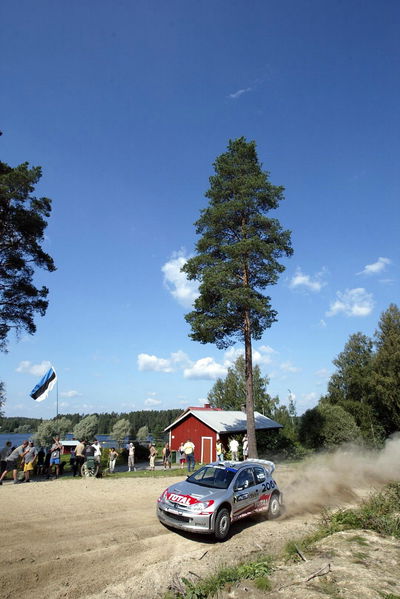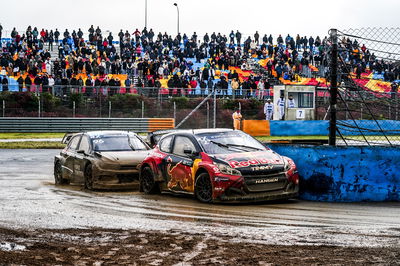Q&A: Aime Chatard - Michelin.
Michelin Competition is responsible for keeping the factory Peugeot 206 WRCs supplied in tyres in world class rallying.
The rallies manager of this key technical partner to Peugeot Sport is Aim? Chatard who talks about the championship's first official foray onto German soil:
Q:
Aime (Chatard). You take an impressive number of tyres to every round of the World Rally Championship. Will the same apply to the Deutschland Rally?

Michelin Competition is responsible for keeping the factory Peugeot 206 WRCs supplied in tyres in world class rallying.
The rallies manager of this key technical partner to Peugeot Sport is Aim? Chatard who talks about the championship's first official foray onto German soil:
Q:
Aime (Chatard). You take an impressive number of tyres to every round of the World Rally Championship. Will the same apply to the Deutschland Rally?
Aime Chatard:
As an all-asphalt round, we will be taking two dry weather options to Germany to cover warm weather and cooler conditions, as well products for damp and wet surfaces. In total, we will have approximately 4,200 tyres available for our World Championship manufacturer partners, including around 800 for the three works Peugeots. On their way to winning the world title for Peugeot in 2001, the 206 WRC drivers 'consumed'... 1,206 tyres. OK, not exactly 1,'206', that's just a quip to pay tribute to the championship winning car, but the figure is not that wide of the mark.
Q:
This will be the first time the Deutschland Rally has counted towards the World Rally Championship. How have you prepared for it?
AC:
When this event was organised as a non-championship event last year, we took part with drivers like Marcus Gr?nholm and the 206 WRC to get an initial feel for the terrain. We then used that information to decide the specifications of the tyres we would need this year. More recently, we carried out tests on site in order to validate a certain number of these solutions. The programme of the Deutschland Rally includes a highly specific leg that runs over dusty, dirty, slippery military ground. For these stages, we have come up with a hybrid half-asphalt/half-gravel product that promises to be particularly useful if more than half of the stage is covered in dirt, as it seems many of them will be. Tyre choice possibly won't be easy, especially if it rains. That would make the stages on military ground extremely slippery and would wash sand and gravel onto those stages run in the middle of the vineyards to the north. Also, as is the case on certain gravel rallies, stage start order could well have an important influence on performance.
Q:
Does basing stage start order for the first day of each round as a function of the drivers' positions in the World Rally Championship lead those who are first on the road to make specific tyre choices?
AC:
As far as the type of tyre or compound are concerned, it is very rare. However, being amongst the first on the road can have a certain influence on the extent to which drivers re-cut their tyres. The fact that there is no miracle solution only serves to underline the merit of the performances of Marcus Gr?nholm, who has led the championship since last February's Swedish Rally. They say a great deal for the way the driver, car and tyre combination functions perfectly well together.
Q:
You work with a number of WRC manufacturer-partners. How, from your angle, do you explain Peugeot's domination?
AC:
In addition to the talent of the team's drivers, the 206 WRC - and notably the 2002 evolution car - is a remarkably balanced machine. In order for the driver, the differentials, the shock absorbers and the tyres to function perfectly in phase, testing is essential and, in this domain, Peugeot Sport has made a significant contribution to the evolution of our products through their desire to progress in all areas. Victory does not come without effort, especially given that Peugeot's rivals are also very competitive and praiseworthy. The domination of the 206 WRC in recent years, notably on asphalt, is not a question of luck and Michelin is proud of the part it has played in that.
Q:
Today's World Rally Cars are impressively balanced machines employing cutting edge technology. What impresses you the most about them?
AC:
Today's WRC cars are about as perfectly balanced as a car can get and significant progress has been made in the realm of electronics, but what has impressed me the most over the past three or four years is the evolution in the rigidity of the chassis; a gain of more than 30%. The benefit of that from our point of view is that the tyres sit much better on the ground. They perform better because they are less deformed. Also, the drivers get more precise feedback from the tyres which means they are less likely to demand too much of them and will employ them more effectively.
Q:
Rally tyres have also evolved. What do you believe to be the most significant progress in this area?
AC:
A road tyre has to be an intelligent compromise between performance, polyvalence and durability. Rally tyres are designed to be extremely efficient over a distance of around fifty kilometres in spite of the phenomenal constraints to which they are exposed. We also need specific products for snow, ice, mud, gravel and asphalt. Having said that, the same tyres are today often asked to cover two or even three stages at a time, which means they have to be more polyvalent than a few years ago. The most recent major development is the durability of our ATS mousse run-flat system. On the punishing, high-speed stages of this year's Safari Rally, not one of the Peugeot drivers had to stop during a stage to change a wheel. Meanwhile, we are progressing on all fronts all the time. On asphalt, we have achieved a gain of two tenths of a second per kilometre compared with last year, that's the equivalent of finding thirty extra horsepower from an engine!










